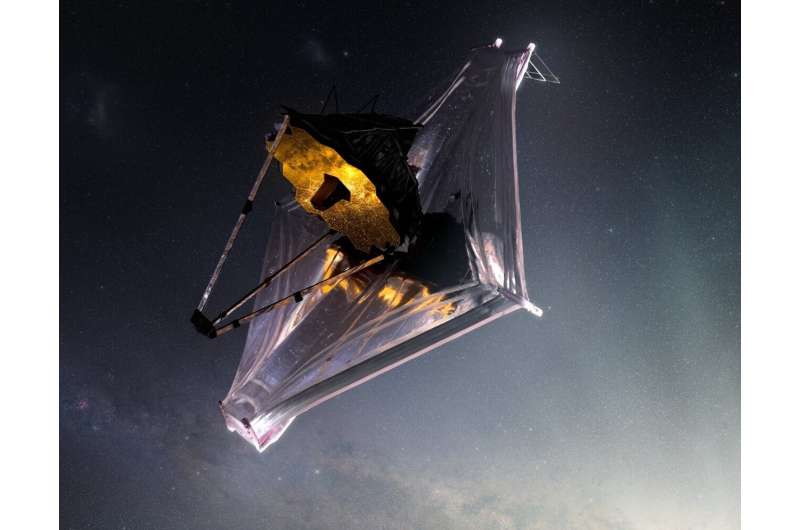The TRAPPIST-1 system, where we may soon have more information about the atmospheres of rocky Earth-like planets from the James Webb Space Telescope. It is possible that the atmosphere contains nitrous oxide, which could indicate life. Credit: NASA/JPL-Caltech
The UC Riverside scientists suggest that the typical list of chemicals astrobiologists use to search for life on planets around other stars is missing something: laughing gas.
Chemical compounds in a planet’s atmosphere that could indicate life, called biosignatures, typically include gases found in abundance in Earth’s atmosphere today.
“There’s been a lot of thought about oxygen and methane as biosignatures. Fewer researchers have seriously considered nitrous oxide, but we think that may be a mistake,” said Eddie Schwieterman, an astrobiologist at the Department. of Earth and Planetary Sciences from the UCR.
This conclusion, and the modeling work that led to it, are detailed in an article published today in The Astrophysical Journal.
To achieve this, Schwieterman led a team of researchers who determined how much nitrous oxide living things on an Earth-like planet could possibly produce. They then created models simulating this planet around different types of stars and determined quantities of N2O that could be detected by an observatory like the James Webb Space Telescope.
“In a star system like TRAPPIST-1, the closest and best system for observing the atmospheres of rocky planets, you could potentially detect nitrous oxide at levels comparable to CO2 or methane,” Schwieterman said.

Nitrous oxide is a constituent of Earth’s atmosphere that provides evidence of life. This image depicts a view of Earth from the moon. Credit: NASA/Lunar Reconnaissance Orbiter Camera Science Team
Living things can create nitrous oxide in several ways, or N2O. Microorganisms are constantly converting other nitrogen compounds into N2O, a metabolic process that can produce useful cellular energy.
“Life generates nitrogenous waste products which are converted by certain microorganisms into nitrates. In an aquarium, these nitrates build up, which is why you need to change the water,” Schwieterman said.
“However, under the right conditions in the ocean, certain bacteria can convert these nitrates into N2O,” Schwieterman explained. “The gas then escapes into the atmosphere.”
Under certain circumstances, N2O could be detected in an atmosphere and still not indicate life. Schwieterman’s team took this into account in their modeling. A small amount of nitrous oxide is created by lightning, for example. But alongside N2O, lightning also creates nitrogen dioxide, which would offer astrobiologists a clue that weather conditions or non-living geological processes created the gas.
Others who considered N2O as a biosignature gas often concludes that it would be difficult to detect from so far away. Schwieterman explained that this conclusion is based on N2O concentrations in the Earth’s atmosphere today. Because there aren’t many on this planet teeming with life, some believe it would be difficult to detect elsewhere as well.

The James Webb Space Telescope could soon send information about the atmospheres of planets in the TRAPPIST-1 system. Credit: NASA-GSFC/Adriana M. Gutierrez
“This conclusion does not take into account periods in Earth’s history when oceanic conditions would have allowed a much greater biological release of N2O. The conditions of those periods could reflect where an exoplanet is today,” Schwieterman said.
Schwieterman added that common stars like K and M dwarfs produce a light spectrum that is less effective at breaking up N.2O molecule than is our sun. These two effects combined could dramatically increase the predicted amount of this biosignature gas on an inhabited world.
The research team included UCR astrobiologists Daria Pidhorodetska, Andy Ridgwell and Timothy Lyons, as well as scientists from Purdue University, Georgia Institute of Technology, American University and NASA Goddard Space Flight Center.
The research team thinks the time has come for astrobiologists to consider alternative biosignature gases like N2O because the James Webb Telescope could soon send information about the atmospheres of rocky Earth-like planets into the TRAPPIST-1 system.
“We wanted to put this idea forward to show that it’s not out of the question that we’ll find this biosignature gas, if we’re looking for it,” Schwieterman said.
Studying the potential for life around the smallest stars in the galaxy
Edward W. Schwieterman et al, Assessing the Plausible Range of N2O Biosignatures on exo-earths: an integrated approach to biogeochemical, photochemical and spectral modeling, The Astrophysical Journal (2022). DOI: 10.3847/1538-4357/ac8cfb
Provided by University of California – Riverside
Quote: Laughing gas found in space could mean life (2022, October 4) Retrieved October 5, 2022 from https://phys.org/news/2022-10-gas-space-life.html
This document is subject to copyright. Except for fair use for purposes of private study or research, no part may be reproduced without written permission. The content is provided for information only.



